Tolman length of simple droplet: Theoretical study and molecular dynamics simulation*
2021-01-21ShuWenCui崔树稳JiuAnWei魏久安QiangLi李强WeiWeiLiu刘伟伟PingQian钱萍andXiaoSongWang王小松
Shu-Wen Cui(崔树稳), Jiu-An Wei(魏久安), Qiang Li(李强),Wei-Wei Liu(刘伟伟), Ping Qian(钱萍), and Xiao Song Wang(王小松)
1Department of Physics and Information Engineering,Cangzhou Normal University,Cangzhou 061001,China
2State Key Laboratory of Nonlinear Mechanics(LNM)and Key Laboratory of Microgravity,Institute of Mechanics,Chinese Academy of Sciences,Beijing 100190,China
3Silfex,a Division of Lam Research,950 South Franklin Street,Eaton,Ohio 45320,USA
4Department of Physics,University of Science and Technology Beijing,Beijing 100083,China
5Institute of Mechanics and Power Engineering,Henan Polytechnic University,Jiaozuo 454003,China
In 1949,Tolman found the relation between the surface tension and Tolman length,which determines the dimensional effect of the surface tension. Tolman length is the difference between the equimolar surface and the surface of tension. In recent years, the magnitude, expression, and sign of the Tolman length remain an open question. An incompressible and homogeneous liquid droplet model is proposed and the approximate expression and sign for Tolman length are derived in this paper. We obtain the relation between Tolman length and the radius of the surface of tension(Rs)and found that they increase with the Rs decreasing. The Tolman length of plane surface tends to zero. Taking argon for example, molecular dynamics simulation is carried out by using the Lennard–Jones(LJ)potential between atoms at a temperature of 90 K.Five simulated systems are used,with numbers of argon atoms being 10140,10935,11760,13500,and 15360,respectively. By methods of theoretical study and molecular dynamics simulation,we find that the calculated value of Tolman length is more than zero,and it decreases as the size is increased among the whole size range. The value of surface tension increases with the radius of the surface of tension increasing,which is consistent with Tolman’s theory. These conclusions are significant for studying the size dependence of the surface tension.
Keywords: Tolman length, surface tension radius of surface of tension, radius of equimolecular surface,molecular dynamics simulation
1. Introduction
A fundamental property of small liquid droplets is the dependence of surface tension on droplet radius, this is size effect.And it is important in chemical physics,for instance,wetting, nucleation, adhesives, condensation, gas absorption.[1,2]Early in the 19th century, Gibbs concluded that surface tension would be subject to the curvature when the droplet size is very small. In 1949, Tolman extended the idea of Gibbs and showed that if the radius of the surface of tension of a droplet does not coincide with the equimolecular radius, the surface tension must vary with droplet size.[3]Tolman derived a relation that has become known as the Gibbs–Tolman–Koenig–Buff differential equation

where γsis the surface tension, δ is the Tolman length, δ =Re-Rs(see Fig.1). Rsis the radius of the surface of tension on which the Laplace’s equation(Δp=2γs/Rs)is valid. The position of the surface of tension is given in the next section.Here,Reis the radius of the equimolecular dividing surface on which Gibbs absorption is equal to zero(Γ =0),or the number of molecules on which is zero.where γ∞is the surface tension of liquid for a flat surface.According the Tayler’s expression, the first approximation of Eq.(2)is

Fig. 1. Schematic diagram of Tolman length δ, equimolecular surface(dashed)and surface of tension(dotted).


From Eq.(3), we can see that δ is an important parameter to obtain γs. Although the Tolman length has received increasing attention, there still exists controversy on the sign and magnitude of the Tolman length. Many researchers considered the magnitude of the Tolman length to be on the order of molecular dimension. However, the experimental determination of the Tolman length is very difficult and the experimental values have not yet been determined. Until now,the sign of the Tolman length is still controversial.[4–9]There are some approaches to studying the Tolman length. One can note thermodynamical method,[10]statistical method,[11]molecular theory,[12]density functional method,[13,14]molecular dynamics simulation,[5,15–17]etc. It is general to assume that δ >0[18]for spherical droplets and δ <0 for bubbles in liquid.[19]By molecular dynamics (MD) simulation Lei et al.[5]showed that the Tolman length is positive, and much smaller in magnitude than previously reported. In particular, they found that the cut-length of interparticle interaction can significantly affect the magnitude of the Tolman length.Blokhuis and Kuipers[10]obtained a relationship between the Tolman length and the isothermal compressibility,and pointed out that the discrepancy in sign or its dependence on the interaction potential is not yet understood. Yan and Zhu,[19]Zhu and Wang,[20]and Wang and Zhu[21]discussed the expression of Tolman length through theory and MD study.More detailed descriptions about Tolman length are reported in Ref. [10].Therefore, the computational, experimental, and theoretical studies of the Tolman length need to be further conducted.The results of these treatments are based on rather complex numerical calculations and on their respective hypothesis, so it would be helpful in determining the sign of Tolman length based on simple model and expressing δ(Rs) analytically in terms of physical properties of the system.
Our work is devoted to studying the Tolman length by theoretical analysis and molecular dynamics simulation. An incompressible droplet model is proposed and the approximate expression and sign for Tolman length is derived in this paper. We find the analytical relation between Tolman length and the radius of the surface of tension. Taking argon for example,molecular dynamics simulation is carried out by using the Lennard–Jones (LJ) potential between atoms at temperature 90 K. Five simulated systems are used, with a total of atoms 10140, 10935, 11760, 13500, and 15360 included respectively. By the theoretical study and molecular dynamics simulation,we find that the calculated values of Tolman length are greater than zero,and it decreases when the size increases in the whole size range.
The rest of the present paper is organized as follows. In Section 2, we give theoretical analysis of the Tolman length.In Section 3 we describe the molecular dynamics simulation,results,and discussion. In Section 4,we present some conclusions drawn from this study.
2. Theoretical analysis of Tolman length
2.1. On derivation of relation formula γs/Rs=γ∞/Re
Some authors have used the relation formula γs/Rs=γ∞/Reas an assumption in thermodynamic treatment[11,22]for Tolman length, and they provided explanation for agreement between derivation and experiment. In this section, the formula is derived by using an incompressible droplet model.
The following main physical parameters are included in Eqs.(4)–(15):
γsthe surface tension of liquid,
γ∞the surface tension of liquid for a flat surface,
Rsthe radius of the surface of tension,
Rethe radius of the equimolecular dividing surface,
pinthe internal pressure,
pothe pressure outside,
pinrthe repulsive pressure in the interior of the droplet,
pinathe attractive pressure in the interior of the droplet,
φIthe potential of particles in the interior,
φSthe potential of particles on the surface.
In the interior of the model,pin=pinr+pinais the internal pressure,where pinris the repulsive pressure in the interior of the droplet formed by the intermolecular rigid repulsive force in two sides of area element. It is positive; pinais the attractive pressure in the interior of the droplet formed by the intermolecular attractive force in two sides of area element. It is negative. We choose an arbitrary area element, u(r) is the potential of intermolecular force and l0is its range. So we have The potential of particles on the surface of the liquid is φS,if is the angle between the vector r and the radius of equimolecular surface Rt,we have

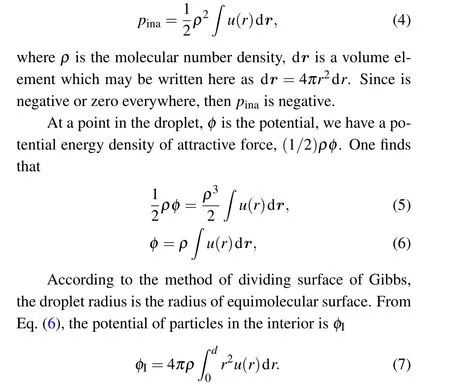
2.2. Magnitudes of Re and Rs
The thermodynamic description of droplet is macroscopic in nature. In order to establish a link with molecular properties, it would seem more natural to use a mechanical picture.This approach would allow one to relate the surface tension and surface of tension of a droplet to microscopic quantities,such as the pressure tensor. By considering the force and moment acting on a hypothetical strip cutting the surface of the droplet, Rowlinson and Widom,[1]and Buff[23]showed that it is possible to obtain a mechanical definition of the surface tension. The position of the surface of tension is given by

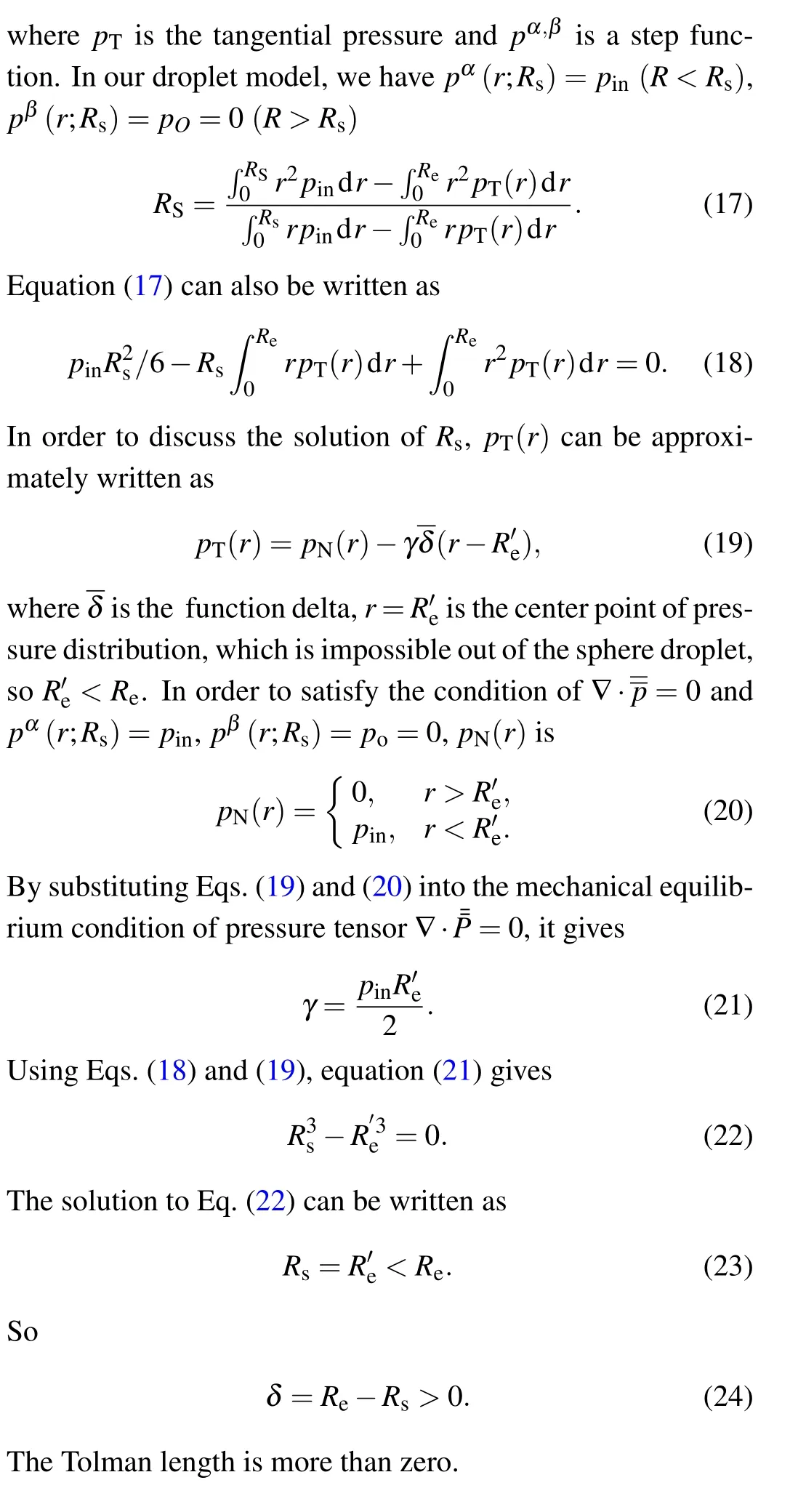
2.3. Analytical relation between δ(Rs)and Rs
In this subsection, we show the analytical relation between δ(Rs)and Rs. Using Eq.(15),we obtain
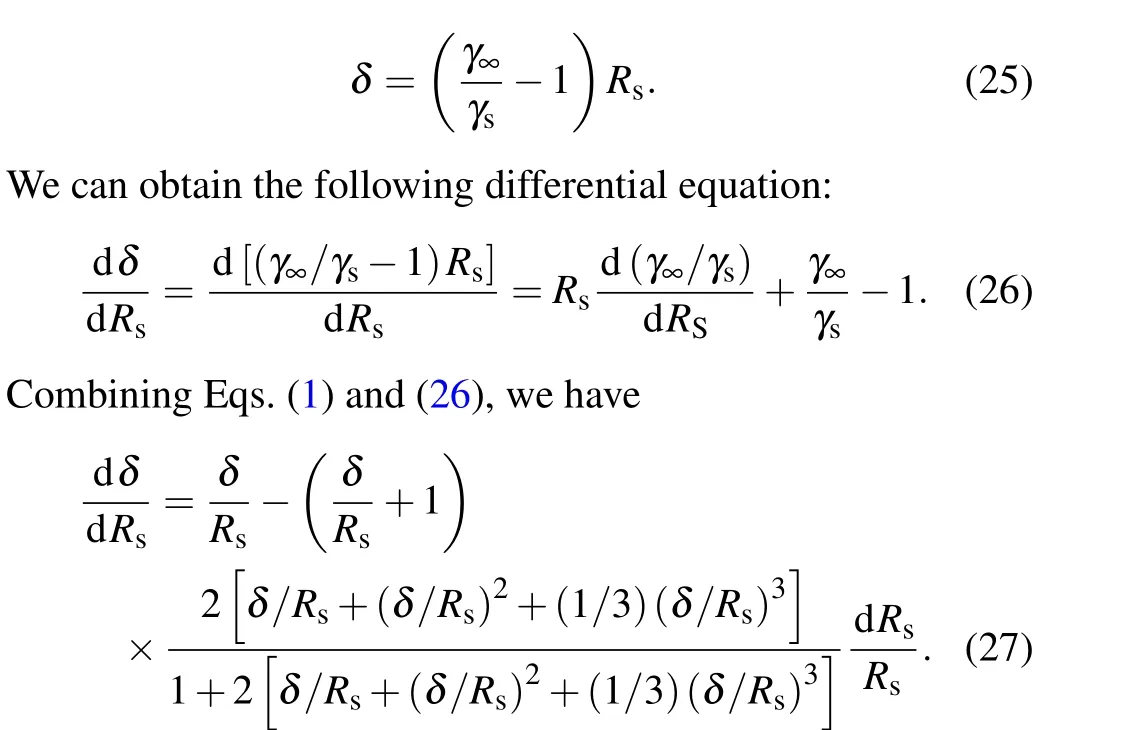
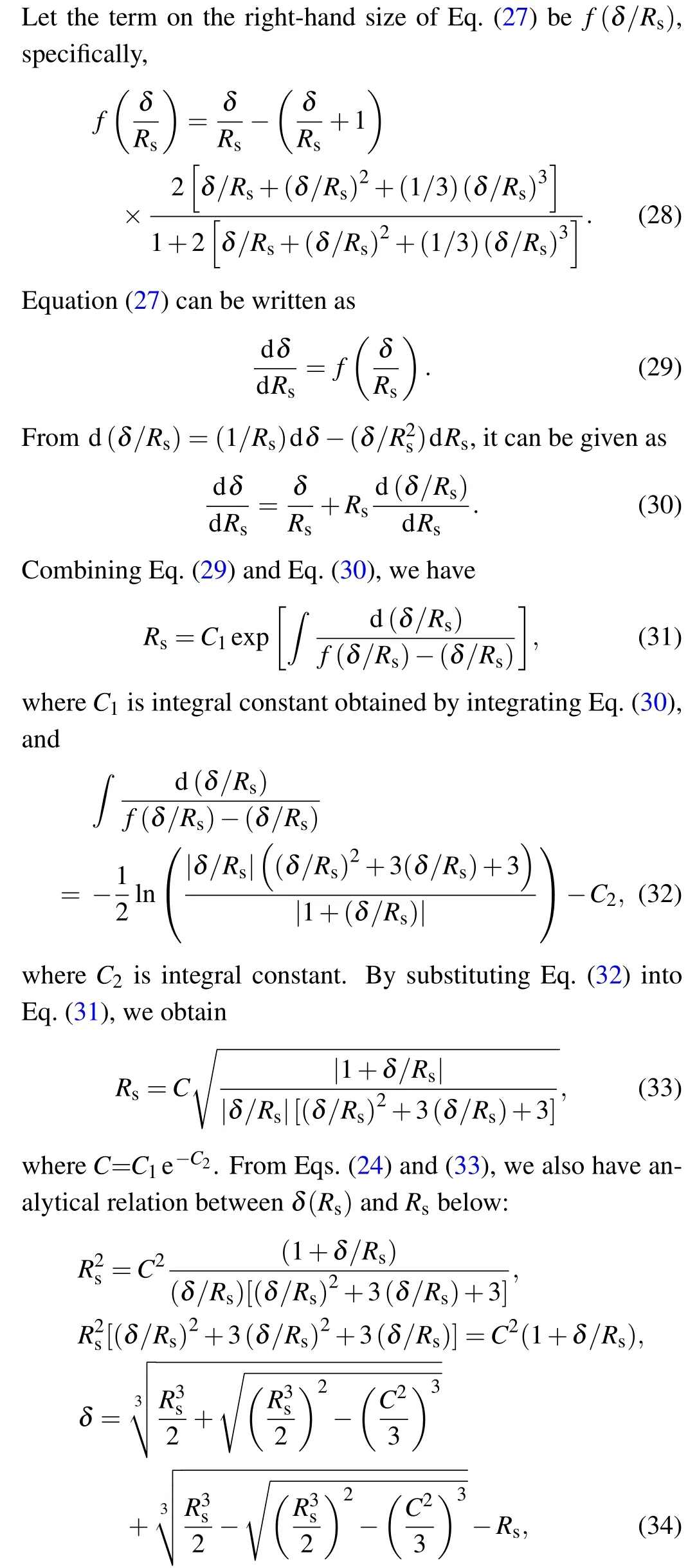
where C is a coefficient depending on physical properties of the system under consideration. It may depend,in general,on thermodynamic conditions like temperature or pressure but is independent of droplet size. The behavior of the solution resembles those of DFT solutions (for example δ =0.2Re[22]).The task of relation of constant C to physical properties of the system remains to be done. We can determine the relationship between δ(Rs)and through a series of values of coefficient as shown in Fig.2.

Fig.2. Variations of δ(Rs)with Rs.
It is observed from Fig.2 that the calculated values of Tolman length are more than zero. It is consistent with the general assumption,[4]that is, δ >0 for spherical droplets. The Tolman length decreases when the size increases in the whole size range, which is consistent with the results of statistical thermodynamics,[22,24]computer simulations results,[25,26]the results from other methods for LJ fluids and the literature[27]δ =0.275 nm(Aurum particle),δ =0.5 nm(cadmium sulfide particle). When Rs>10 nm, the effect of droplet size on the Tolman length can be omitted,and the abrupt increase occurs at Rs<5 nm. The asymptotic Tolman length (δ∞) tends to zero in the limit of Rs→∞.
3. Molecular dynamics simulation, results, and discussion
In molecular dynamics simulations,the intermolecular interactions between argon atoms are described by the Lennard–Jones potential
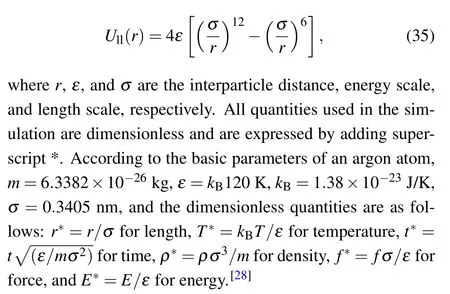
The initial configuration is constructed on a finite cubic lattice located in the central part of the box, and the argon atomic separation is 1.2σ. The box size of simulation system is x×y×z=6.13 nm×26.56 nm×26.56 nm. The periodic boundary condition is used in the x direction and mirror boundary condition is used in the y and z directions. The simulated temperature is T*=0.75. The cut-off distance is rC=3.0.
Five simulated systems are used, with numbers of argon atoms being 10140,10935,11760,13500,and 15360 respectively. Some details of molecular dynamics simulation can be referred to our article.[28]For the simulated systems,at the initial time all the particles are given velocities according to the Maxwell–Boltzmann distribution. The velocity–Verlet algorithm is used in molecular dynamics. The time step δt =5 fs is used before equilibrium. When the equilibrium is reached,then we perform on the statistical treatment of the physical quantities of the system. When calculating the mean value of a physical quantity,we change the time step into δt=2 fs. In order to find whether the step number N that is needed for a physical quantity,say,g(t)reaches its steady value,we use an accumulative average method for the statistics
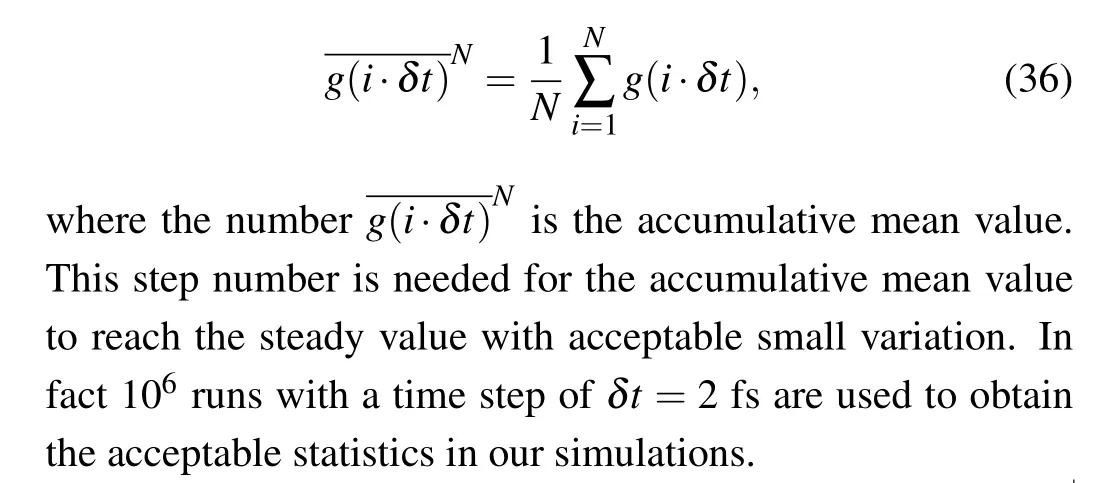
The density profile of N = 11760 system is shown in Fig. 3. The statistical time steps are 106runs. A configuration of system is recorded by every 100 runs. The average result is obtained by 104samples. The example of the density profile is obtained with this method.

Fig.3. Density profile of N=11760 system.
The details of the calculation of γsand Rsare given in Ref. [29]. Here we only give the brief calculation. The numerical functions γsand Rsare calculated from the following equations:


Table 1. Values of pα, pβ,P2,γs,and Rs of molecular dynamics simulation.
The values of ρl,ρv,Rs,Re,and δ of molecular dynamics simulation are listed in Table 2.

Table 2. Values of ρl,ρv,Rs,Re,and δ of molecular dynamics simulation.
The dimensional dependence of the surface tension is associated with the Tolman length. The values of Rsand Reare very close to each other, and they increase with N increasing. We can see that our result of molecular dynamics simulations for a Lennard–Jones system show that the Tolman length is more than zero.[25,26]Our result of Tolman length being positive for an argon droplet is also consistent with that of Thompson’s.[30]
In addition, we also make a qualitative comparison of the above theoretical study. The values of the Tolman length calculated from the theoretical study and molecular dynamics simulations are shown in Fig.4.
Comparing with the above theoretical curve, we can see that the value of the Tolman length from molecular dynamics simulation is in agreement with those from theoretical study at large Rs. The Tolman length from simulation deviates from the theoretical curve at small Rs. But in both cases it seems clear that the Tolman length decreases with Rsincreasing,and δ >0. Small systems exhibit a significant oscillation in surface tension which is due to size effect. The finite-size effect can be the origin of this discrepancy.A precise quantitative estimate of this effect by numerical simulation would need very long computation time in order to obtain acceptable statistical errors and has not been realized in the present paper. Besides,the values of γsin Table 2 increase with the radius of surface of tension (Rs) increasing, which is consistent with Tolman’s theory.

Fig. 4. Values of the Tolman length calculated using theoretical study and molecular dynamics simulation.
4. Conclusions
For decades the behavior of Tolman length has remained one of the most controversial issues in nanoscopic mechanics. For the Tolman length of incompressible and homogeneous liquid sphere,we obtain the relation between δ(Rs)and Rs,and found that they increase with Rsincreasing. The Tolman length of plane surface(δ∞)tends to zero in the limit of Rs→∞. Five simulated systems are used in molecular dynamics simulation,with numbers of argon atoms being 10140,10935, 11760, 13500, and 15360 respectively. By the theoretical study and molecular dynamics simulation,we find that the calculated values of the Tolman length are more than zero,and they decrease as the size increases in the whole size range.The values of surface tension increase with the radius of the surface tension increasing,which is consistent with the result from the Tolman’s theory. These conclusions are significant for studying the size dependence of the surface tension.
杂志排行
Chinese Physics B的其它文章
- Two-dimensional finite element mesh generation algorithm for electromagnetic field calculation*
- Stable water droplets on composite structures formed by embedded water into fully hydroxylated β-cristobalite silica*
- Surface active agents stabilize nanodroplets and enhance haze formation*
- Synchronization mechanism of clapping rhythms in mutual interacting individuals*
- Theoretical study of the hyperfine interaction constants,Land´e g-factors,and electric quadrupole moments for the low-lying states of the 61Niq+(q=11,12,14,and 15)ions*
- Ultrafast photoionization of ions and molecules by orthogonally polarized intense laser pulses: Effects of the time delay*
